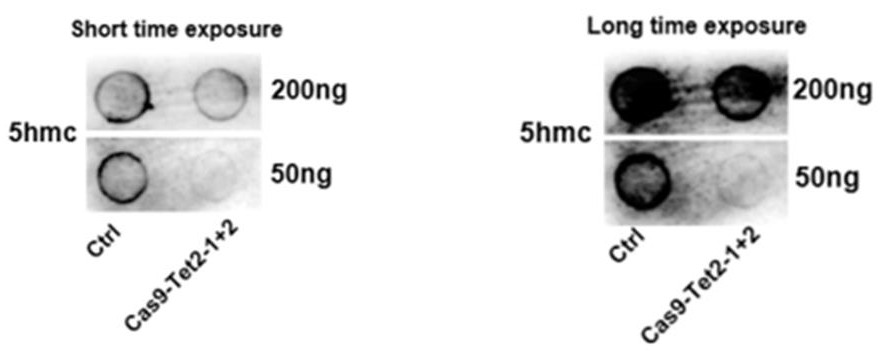Method for knocking out TET2 gene of human bone marrow mesenchymal stem cell by using CRISPR-Cas9 (clustered regularly interspaced short palindromic repeats-associated 9) system
A bone marrow mesenchymal and TET2 technology, applied in the field of bioengineering, can solve the problems of high off-target rate and low efficiency, and achieve low off-target rate, strong specificity, complete and thorough effect
- Summary
- Abstract
- Description
- Claims
- Application Information
AI Technical Summary
Problems solved by technology
Method used
Image
Examples
Embodiment 1
[0023] Example 1: Construction of CRISPR-Cas9 targeting vector
[0024] (1) Design gRNA for the target sequence
[0025] For the TET2 gene, open the website NCBI Pubmed, enter "target gene name: tet2, species: human" to obtain the genomic information of the target gene (gene name: TET2, gene ID number: 54790, gene details see https: / / www .ncbi.nlm.nih.gov / gene / 54790), determine the genomic sequence position of the target gene TET2, determine the position of the start codon ATG, download the genomic information of the target gene and name the file "TET2 geneome from Genebank". The TET2 partial genome sequence (SEQ ID NO: 1) was thus obtained: CAACCAAATG TCTCCGATTTGAGTGATAAG AAAGAATCTG TGAGTTCTGT AGCCCAAGAA AATGCAGTTA AAGATTTCAC CAGTTTTTCAACACATAACT.
[0026] Using Sanpgene software, open the above file and design a gRNA targeting exon 3 for the TET2 gene. The computer will automatically analyze the position of the gRNA on the gene sequence and the off-target (off-target) informa...
Embodiment 2
[0085] Example 2: Validation of CRISPR / Cas9 knockout efficiency in eukaryotic cells
[0086] (1) Plasmid amplification
[0087] 1) Take out 100 μL of E. coli competent cells (DH5α) from the -80°C ultra-low temperature freezer, put them on ice, and gently suspend the cells evenly after they are completely thawed;
[0088] 2) Add 1 μL of plasmids (lentiCRISPR v2-TET2-gRNA1, lentiCRISPR v2-TET2-gRNA2), mix gently, and place on ice for 30 minutes;
[0089] 3) Heat shock in a water bath at 42°C for 60s, and place on ice for 2min;
[0090] 4) Add 1mL LB / tube and operate in the ultra-clean workbench;
[0091] 5) Shake the bacteria for 30min, centrifuge to separate the supernatant and sediment;
[0092] 6) Discard 800 μL of the supernatant, and mix the rest to spread on the ampicillin plate;
[0093] 7) The plate was placed forward at 37°C for 10 minutes to absorb excess liquid, and then inverted overnight (about 12h);
[0094] 8) Pick a single colony from the ampicillin culture ...
Embodiment 3
[0137] Example 3: Construction of TET2 knockout human bone marrow mesenchymal stem cell line and identification of knockout effect
[0138] (1) Preparation of passaged cells:
[0139] 1) This study was approved by the Ethics Committee of Tongji University School of Medicine and Tongji Hospital. #1, #2 and #3 bone marrow mesenchymal stem cells (MSCs) were isolated from patients undergoing fracture surgery without acute systemic disease, malignancy or endocrine disorders.
[0140] 2) Culture MSCs cells in complete medium at 37°C with 5% CO 2 , and passaged when the cells reached 90% confluency. MSCs complete medium: 10% FBS+DMEM / F-12+NEAA or BMSCs complete medium purchased from Cyagen, the product number is HUXMA-90011.
[0141]3) Use 0.25% trypsin to digest cells for passage plating: 12mL of cell suspension (3x10 6 ) were evenly plated into 6-well plates, and the cells were ready for transfection the next day when the cells reached 70-90% confluence.
[0142] (2) Cell tran...
PUM
 Login to View More
Login to View More Abstract
Description
Claims
Application Information
 Login to View More
Login to View More - R&D
- Intellectual Property
- Life Sciences
- Materials
- Tech Scout
- Unparalleled Data Quality
- Higher Quality Content
- 60% Fewer Hallucinations
Browse by: Latest US Patents, China's latest patents, Technical Efficacy Thesaurus, Application Domain, Technology Topic, Popular Technical Reports.
© 2025 PatSnap. All rights reserved.Legal|Privacy policy|Modern Slavery Act Transparency Statement|Sitemap|About US| Contact US: help@patsnap.com



